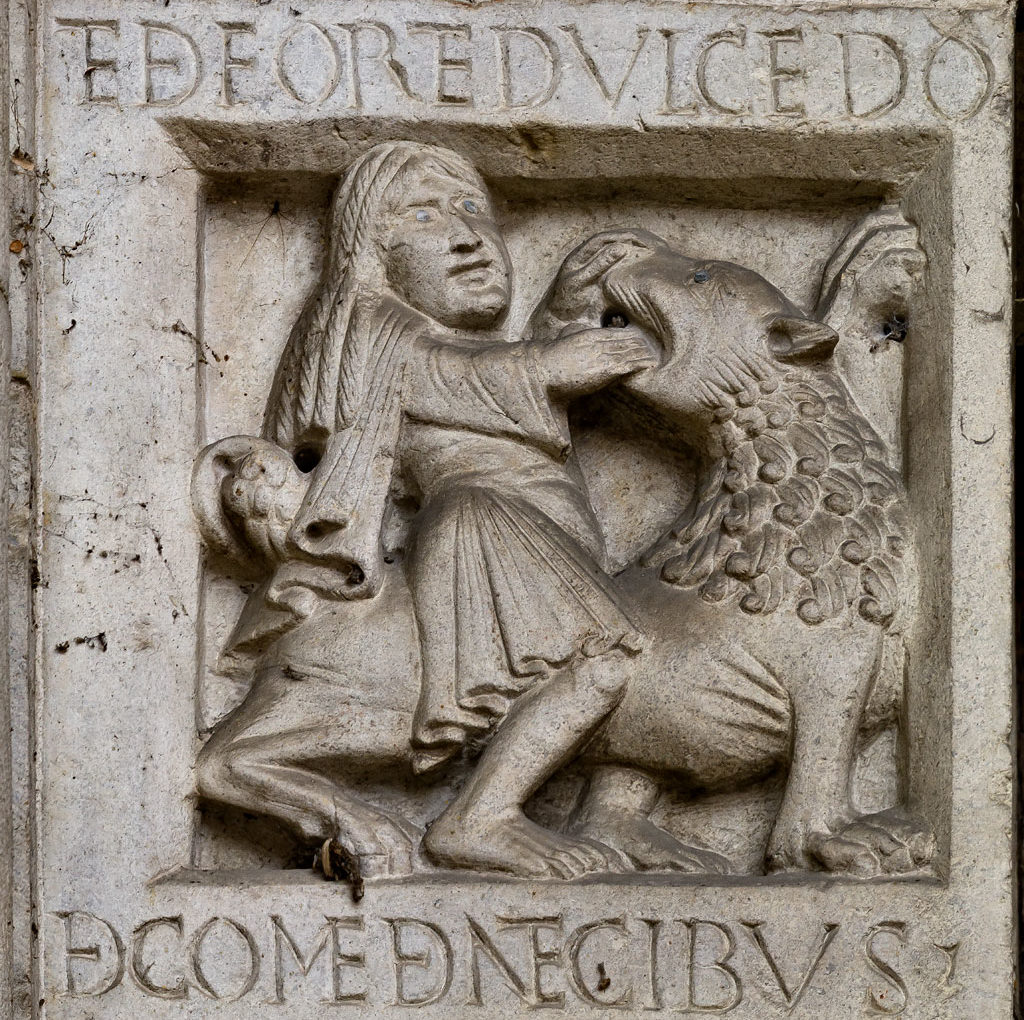Abbazia di Nonantola, facciata, portale: le formelle dello stipite sinistro (faccia esterna). Le formelle, commissionate dall’Abate Rodolfo, furono realizzate tra il 1002 e il 1032 e narrano la fondazione dell’Abbazia e i suoi primi secoli di storia. Dal basso verso l’alto si osservano: Telamone; i Longobardi Astolfo ed Anselmo in vesti nobiliari; la fondazione: il re Astolfo dona al cognato Anselmo la terra di Nonantola ed il primo nucleo di beni (rappresentati dalla zolla); Anselmo, fattosi monaco, e la prima abbazia; Anselmo e i monaci chiedono al papa il corpo di San Silvestro; Il trasporto delle reliquie di Silvestro verso Nonantola; la sepoltura del corpo di San Silvestro in abbazia; la morte di Sant’Adriano III Papa nei pressi degli attuali San Cesario sul Panaro/Spilamberto; i monaci traslano la salma di Sant’Adriano verso l’abbazia; la sepoltura di Papa Adriano in abbazia; Sansone squarcia a mani nude il leone. Iscrizioni in latino: de forte dulcedo / de comedente cibus (Dal forte è uscito il dolce e dal divoratore è uscito il cibo). Si tratta del famoso indovinello di Sansone (Giudici XIV, 14). Con un’allegoria ci indica che coloro che dominarono, impossessandosi anche dei beni della chiesa (cioè i Longobardi) fornirono il cibo per i monaci (la donazione di Astolfo) e dallo stesso seno della dinastia dominante uscì la dolcezza del fondatore dell’abbazia.
Nonantola Abbey, the façade, the portal: the left jamb panels (external face). The panels, commissioned by Abbot Rodolfo, were made between 1002 and 1032 and narrate the foundation of the Abbey and its first centuries of history. From bottom to top you can see: Telamone; the Longobards Astolfo and Anselmo in noble garments; the foundation: King Astolfo donating the land of Nonantola and the first group of assets (represented by the clod) to his brother-in-law Anselmo; Anselmo, who has become a monk, with the first abbey; Anselmo and the monks ask the pope for the body of St. Sylvester; the transport of St. Sylvester’s relics to Nonantola; the burial of St. Sylvester’s corpse in the abbey; the death of Pope Saint Hadrian III near the current San Cesario sul Panaro / Spilamberto villages; the monks move Pope Hadrian’s corpse towards the abbey; the burial of Pope Adrian in the abbey; Samson tears open the lion with his bare hands. Latin inscriptions: de forte dulcedo / de comedente cibus (sweet was born from sour and from the devourer the food came out). This is the famous Samson’ riddle(Judges XIV, 14). By using an allegory, it indicates that those who dominated by taking possession of the church’s property (the Longobards) provided food for the monks (the donation of Astolfo) and, from the same the dominant dynasty, the sweetness of the founder of the abbey came out.
